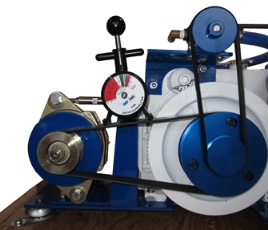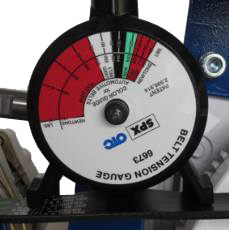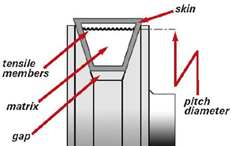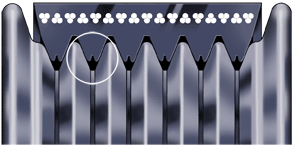6.Do Not Do - ILL Advised: Not to mention the
Cost vs. Gain
A common question we receive is regarding
how to modify the water pump pulley to allow for dual belts. Simply, the answer is
NO. The water pump/pulley is not designed for the side loading that will be impacted by a device that requires two belts. A developing situation
that then arises is that they then want to have a double sheave crankshaft pulley with split loading. First, they want to place one belt around the first sheave, water pump/pulley, and then
on to the pulley of the device requiring 2 belts. Next, they then want to place the second belt around the crankshaft second sheave and then on to the device that requires the second sheave
without going around the water pump/pulley. Simply, the answer is NO, again. You can not have belts of two different sizes to drive a device. Belt tensioning will never be equal on the
two belts. All the devices will have uneven stress, belt wear, ... The two situations discussed above are to be avoided. We have received numerous emails from various sources that describe
this scenario over and over. Normally, it is the result of someone attempting to be cute, lack of space, lack of $, .... Ultimately, a lack of understanding engineering principles will
eventually cause failure regardless of personal requirements or resources. Do it right the first time or don't do it at all. One does not always get the chance to pull over to nearest dock
(and fix it).
7.BELT and Pulley Size vs. Amp Loading (at 12vdc)
One of the most common questions asked. What is the smallest or largest belt / pulley combination may I install on my engine, water pump, alternator, .... The combinations of this
question with different variables is endless. On your existing engine system, whatever the manufacturer designed it to have is what you have to live with without modification (Westerbeke
is the only exception we have found to this rule, but not really because they were designed for higher loads even though the standard installation is a single 3/8" v-belt.). To increase
your basic installed belts and pulleys beyond what they were designed for - Did you read 7?
Bottom line is as follows:
• single 3/8" vbelt supports up to apx. 70 amps
• single 1/2" vbelt supports up to apx. 94 amps
• double 3/8" vbelts supports up to apx. 140 amps
• double 1/2" vbelts supports up to apx. 300 amps
• single 8 groove serpentine belt supports up to apx. 300 amps
Exception to carefully note: If your use a single 3/8" belt exceeding 70 amps up to a 94 amp load, be aware it will work, but possible ramifications are increased side loading of the water
pump, alternator, and v-belt. This will probably decrease water pump and belt lifespans significantly. Extra spares are a must - Do not forget a spare water pump, not just the impeller.
The corresponding limit for a single 1/2" v-belt is 120 amps.
8.Most often asked Question and Answer putting the above (4,5,6,and 7) in perspective
I have a model _______ (fill in the blank) Engine and I am tired of loose alternator belts and black belt dust all over the place.
Do you have a pulley and belt kit to upgrade standard equipment alternator belt to serpentine? If so, how much does it cost? Does it replace the old pulley
or mount to the old pulley?
Usually this situation comes about from one of three scenarios - Improper
installation (alternator & pulley alignments), improper or lack of
tensioning, or constant
overload. Refer to 4 and 5 above regarding belts and tensioning. Regarding item 6 - Based on your engine size, you may be in a situation that you are
overtaxing your existing alternator (battery bank size in excess of 500AH and using a single alternator of limited output). If your battery bank exceeds 500ah, certainly by 600-700ah, you
probably need our second High Output Alternator (ZCCJE1222, 220+ amps). Also, the cost to do the mods you were considering are as expensive as adding a second High Output Alternator in the
first place. Again, the mod you were considering is a no go item. Contact us via a phone call for full details regarding your specific situation.
Bottom Line - A
properly designed /engineered system works perfectly with either a CORRECT & PROPER V-Belt OR a Serpentine Drive belt. Wanting to change to a serpentine
belt system before the underlying problem is discovered and a proper solution path is chosen, is like prescribing aspirin for an unknown infection. It may possibly help in the short
term, but the long term results will not be known and may cause destruction.
|



